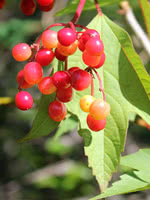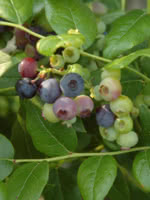Mon-Fri 9am - 5pm Mountain time
Highbush Cranberry vs Chippewa Blueberry
Viburnum opulus var. americanum (trilobum)
Vaccinium x Chippewa
Highbush Cranberry produces attractive white flowers in late June and bears edible fruit that matures to a bright red colour in the late summer.
This shrub, native to much of Canada, is fast growing, and its fruit can be eaten raw or cooked into a sauce.
Chippewa Blueberry is the perfect shrub for attracting birds and butterflies. Incredibly cold-hardy, the Chippewa Blueberry is an upright shrub making it easy for harvesting. Known for producing high yields of large blue-colored berries, this blueberry is a favourite for fresh eating, baking, and preserves. As with all blueberries, the Chippewa needs soil with a low pH and high acidity.
Highbush Cranberry Quick Facts
Chippewa Blueberry Quick Facts
In row spacing: 0.6 m (2.0 ft)

